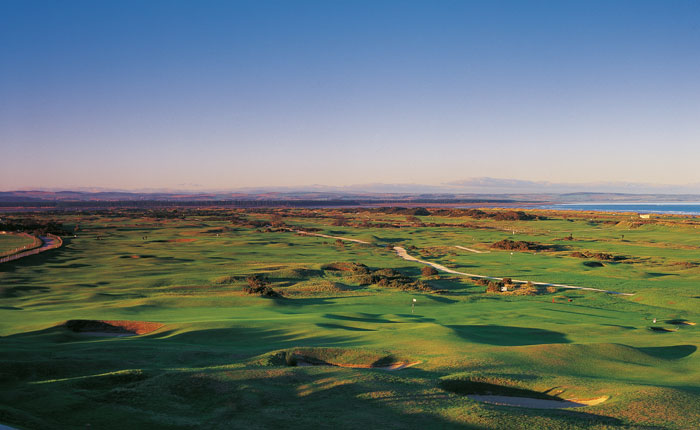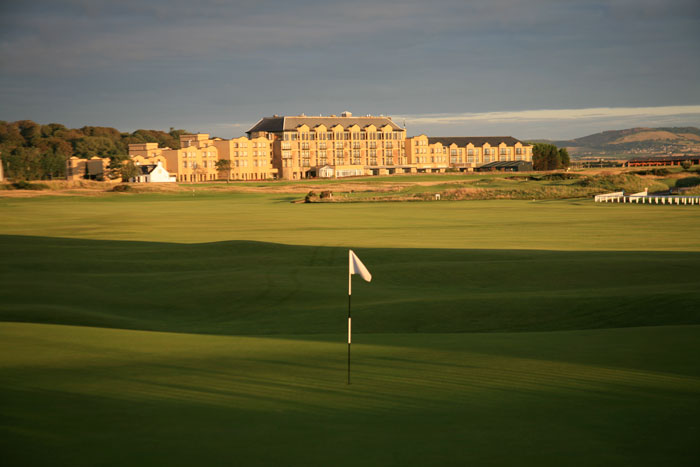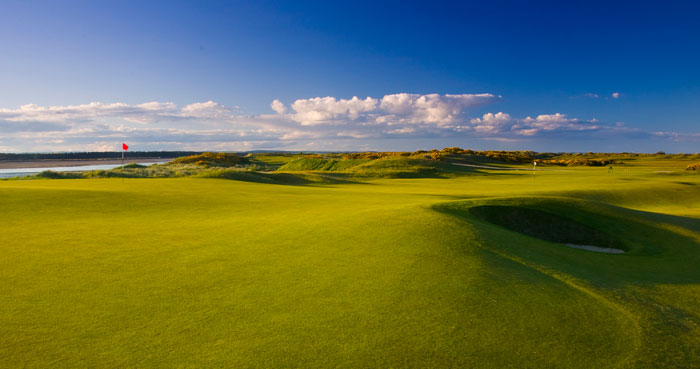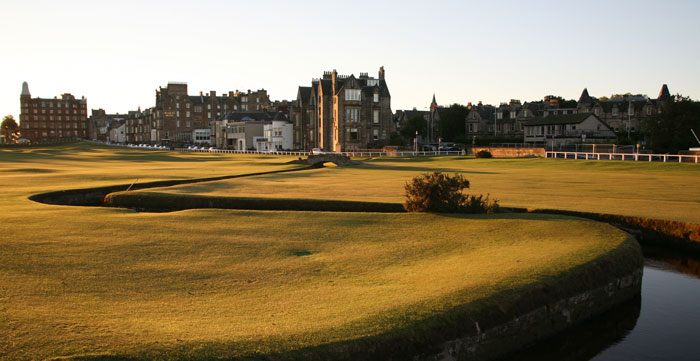
The morning was cold and a cutting wind blew over the Old Course like a knee in the groin. As my friend and fellow golf writer Tom Harack and I watched a couple of guys we knew teeing off on the first hole of the most famous golf layout on the planet– a gorgeous, rugged place of power and pilgrimage, a sacred place of homecoming and deep emotion– we huddled close in the freshening breeze and whispered “Miss it. MISS IT!” at their back swings.
Despite the weather a ragged gallery clustered around the first tee: golfers awaiting their times, caddies milling about smoking, townsfolk shuffling off to work, and endless brigades of tourists circling the Royal and Ancient Clubhouse in goofy wonder, toting shopping bags full of logoed sweaters and drink coasters, club-head covers, tee-shirts, tartan neckties, boxer shorts, jock straps, condoms, hollow-point bullets, and Lord only knew what else, all sporting the famous St. Andrews crest. They stood in awe, these spectators, with quiet smiles on their lips and envy blossoming in their hearts, all of them, I think it is safe to say, repeating– consciously or not– the same mantra: “Miss it. MISS IT!”
I began developing this bitter and cynical attitude toward St. Andrews several years ago when I visited Scotland to gather material for my first book. My friend Tom Liszewski, who runs an excellent golf travel service called Golf Vacations, in Boston, was kind enough to set up my itinerary. Although Tom managed to book complimentary tee times on eleven great golf courses throughout Scotland (many of which he arranged for me to play with club Secretaries, or other dignitaries); and although he scored free hotel rooms (including a suite at the Balmoral in Edinburgh that was so large I got lost looking for the bathroom late one night), Tom was unable to secure anything from the powers-that-be at St. Andrews besides a snooty letter.
The circumstances surrounding this current visit did little to improve my attitude. In spite of the fact that I’d traveled more than 6000 miles, on three airplanes, in coach, and then climbed aboard a bus for a three hour ride to spend a mere four days in St. Andrews; regardless that I was a guest of the posh Old Course Hotel, which practically straddles the famous Road Hole; and without consideration that our group of golf writers had been invited here specifically to write about and promote golf in St. Andrews, the reigning powers wouldn’t even guarantee us a tee time on the Old Course. St. Andrews also threw bunker sand in our faces by insisting that we’d have to pay the greens fees–if they even deemed us worthy to jab our spikes in their grass.

Throughout my life I have always felt as though I am somehow special, and that rules don’t apply to me. My mother confronted me with this fact several million times during my childhood, and though it pains me to say so, my mother was right. So when St. Andrews royally kicked me in my egotism for the second time I grew angry and vengeful. But behind these easy emotions, of course, cowered fear and helplessness over a situation in which something I so badly wanted lay beyond my own control– an experience that most avid golfers can probably relate to.
After our companions hit successful tee shots on the first hole of the Old Course and chased happily after them, and still a half hour before Tom’s and my own tee time, I asked the starter if there wasn’t someplace we could retreat indoors to get warm while we waited. From inside his toasty booth he raised a steaming mug of tea in mock “cheers,” threw his head back, and laughed like one of us was insane.
(Okay; he actually told me I could walk half a block to the Woolen Mills Store, but I distinctly noticed that he said this with an ATTITUDE– though maybe that was just his accent).
Scotsmen have been playing golf on the location of the Old Course in St. Andrews for over 500 years. In 1552 a local Archbishop passed a decree granting the townspeople the right to pursue “gaof, futeball, and shuting” on the local links in perpetuity. Although the Archbishop wasn’t much of a speller, his word was law. Approximately 60% of the available tee times on the Old Course are currently reserved for town residents, who still play there as if it were a semi-private club. Which in fact it is.
But chances are that you’re not a Scotsman. So if you’d like to play golf on the most famous course in the noosphere, good luck. And get in line. If you didn’t happen to book a tee-time a year in advance, the only way to secure this rare commodity is to enter the daily ballot. Every afternoon, the mystical powers at St. Andrews randomly select lucky balloteers to fill open tee times for the following day. While the chances are good that you’ll get on if you’re in town for a while, it is also entirely possible that you won’t. Although I’d been working hard not to measure myself by such external circumstances, I couldn’t help feeling that my success or failure in the ballot would provide a physical manifestation of my accrued golf karma: only a loser would travel so far to come here and not even get on the course. Detachment was not an easy lesson to master.
Learning that we had to enter the ballot fattened me with further anger and disdain, and elicited that spoiled-brat head shaking that my mother tried so tirelessly to cure me of. But I have since come to realize that while the ballot system is as arbitrary as sacrificing a virgin to the volcano Gods, it is perfectly philosophical for the same reason: it allows Providence to decide whether we are, in fact, worthy of playing golf on the game’s most sacred layout. And that is the pure and unarguable beauty of the system. That it remains– just as our best golf rounds most often do– beyond willful control. I had no choice but to throw a tantrum or let go– and I wasn’t entirely sure which constituted a better course of action.
On our first afternoon in St. Andrews, Tom Harack and another golf writer and I played a joyful, disorientedly jet-lagged round of golf on the town’s Jubilee Course, finishing just as the stone-gray buildings and the blue sea sopped up the last pools of afternoon light. Upon sinking my final putt I skipped back to my room in anticipation only to discover that we had not, in fact, been awarded a tee time on the Old Course for the next day.
So instead, we made our way ‘round the excellent Duke’s Course, an inland layout designed by five-time Open Champion Peter Thomson, and owned by our friends at the Old Course Hotel. Tom and I competed against two staffers from a now-defunct golf magazine in a $2 Nassau. The course itself pitched and rolled and undulated musically between pines and birches, through varicolored grasses, over burns, around ponds, and past patches of heather and gorse, but all I could focus on was our stupid, stupid bet. Though I’d been hoping to shoot in the low eighties in preparation for breaking through to a new personal best on the Old Course should I merit the opportunity to play there, I would have needed to cheat just to break 100 that day on the Duke’s. And I seemed perpetually married to performance.
After lunch in the stately Clubhouse, Tom (having earned the new nickname “Bunker Boy”) and I caught a ride to the Ladybank Golf Club– an Open qualifying site– to see if we couldn’t rescue the respectable remnants of our games. While this morning’s sorry impetus was to win a $2 Nassau, this afternoon presented me with an even more senseless goal. Although only five of us were playing golf on this press trip, our hosts had promised to award prizes for the lowest score on each course each day, the lowest overall score, and the best Stableford tally. This afternoon, since Tom was the only other golfer (and since his putting stroke seems like a desperate cry for help), I figured my chances were pretty good to turn in the low net. And oh what an admirable role model I’d be!
I recognized the small, small pitiful nature of my desire to “win,” yet I still proved incapable of letting go of performance. I played ignominiously and with great self-consciousness, barely noticing the elegant pines, the way the steep bunkers cast rounded shadows, the pewter, cerulean, and orange colors of the sky. At dusk we crawled home to learn once again that we had not been granted the honor of playing the Old Course the next day.
That night I tussled with a kicky eighteen year-old scotch at the Road Hole Bar in our hotel. Then I ate far too much good food, drank too much Merlot, and excused myself at eleven. But I was too restless to sleep, so at midnight I pulled on some clothes and went walking.
I ambled out behind the hotel along a shell path that ran beside the seventeenth hole (the Road Hole) of the Old Course. After glancing feloniously to make sure no one else was about, I crossed onto the most well-known fairway in golf, feeling an illicit thrill. I sneaked between the deep bunkers and up to the green.
Standing next to the pin, with a light rain tinkling and the world dark around me, I felt a weird cocktail of fear and longing and a schoolboy sort of love for the place I was standing. And all at once my anger broke up and drained away. I am not embarrassed to admit that I whispered a quiet prayer. I prayed not for a tee time, or to break eighty, to meet a mermaid, or for my books to sell a million copies. I prayed for the courage to be able to play golf– and to live– without fear.
My anger, I recognized right then, as the night wind blew over the linkslands, was a cheap suit dressing up the fear of not getting what I wanted. I was mad at St. Andrews because it had failed to recognize me as someone special. As I appealed to whatever spirits ruled this place it came clear to me that I live my life afraid of most everything: of not performing well, or of what other folks might think of me; of slicing a tee shot or blading a pitch or three-putting a green; of letting go of control enough to let someone get intimate; of wearing the wrong shoes or choosing the incorrect fork or spilling red wine on my white shirt. And, mostly, of making bad choices and being treated unfairly and not getting what’s coming to me. Yet instead of acknowledging my fears, I disguise them with anger, often fooling even myself about how I really feel. This has been the self-protective and deceitful architecture of my life, and the very thing that many non-traditional golf instructors over the years had tried to help me deconstruct so that I might live more fully, and– incidentally– play better golf.
Standing beside the wind-rippled flag of the Road Hole as rain percussed around me and clouds obscured the moon, I even feared catching cold or ruining my coat. I tried to let go. I breathed deeply into my solar plexus. I pledged to live differently and more fully. I asked for help, and to be worthy of the honor of playing golf here. I let the rain fall without wishing it would stop, knowing that the rain couldn’t give a rip about what I wished or knew.
Eventually I stepped toward the eighteenth green, crossed Swilcan Bridge, circled the Royal and Ancient clubhouse, and continued down to where the burn tongued into the North Sea. Looking out over the water I thought about my life and how it had led me here. Some students from the University waltzed drunkenly past and I grew skittish, afraid they might speak to me and interrupt my solitude. I tightened, then laughed at yet another example of my fear.
After listening to the breakers playing a beat of whoosh-whoosh-boom against the shore, I retraced my steps back toward the hotel. Walking across the shared first/eighteenth fairway I felt the soft turf relenting under my shoes. And then, looking up, I spotted a pair of headlights advancing toward me down the path adjacent to the hole. From atop the vehicle a searchlight swept back and forth over the links, combing the grassy expanse with light.
The car was still two hundred yards away, and as it crept steadily closer I knew I had enough time to sprint for cover, to throw myself down in a bunker or press my body flat against one of the rolling mounds that made for such difficult lies. But I also recognized that I was being tested. I understood that the challenges of this golf course were not limited to hitting a ball with a stick.
As the vehicle closed the gap between us, everything in me shouted flee! run! hide! get out of the way before you’re exposed! But another voice– calm, unfamiliar, slightly officiously super-hero like– reminded me there was nothing to be afraid of.
Run, moron! the first voice hollered.
I sunk my hands into the pockets of my field coat, squinched my eyes at the darkness, and strode ahead. I kept walking, though fear and adrenaline protested my aplomb. Just before the searchlight illuminated my terror and horns blared and security sprinted across the sacred grass to tackle me and drag me away, the light simply went out. The vehicle drove close, closer, parallel, and then past me. And then the light went back on. I strolled back to my hotel, laughing, and slept hard.

The next morning, my Scottish friend and former college soccer coach John Wallace, whom I hadn’t seen in fourteen years, drove down to St. Andrews from his home in nearby Fraserburgh for a day of golf. He and Tom and I rode over to Crail and played the gorgeous links course there in wind and sun and hail and cool rain, smoking good cigars, telling old stories and inventing some new ones. On the first tee I relinquished the score card to Tom and stopped chafing about numbers– even when I hit into a deep bunker on the ninth and flailed on several shots before escaping. Even after slicing my drive into the ocean on an easy par five. Even after three-putting a flat green. I simply valued the camaraderie, the chance to play this beautiful game with friends who lived far away, and whom I might not see again anytime soon. I just played. Played! Like a boy. I shot 89, Tom informed me, as we sped home for a quick lunch before venturing out on St. Andrews’ New Course in the afternoon. The voices of my many coaches were lost in the simple purity of surf crashing on the beach.
We teed off at just after 3:00 and the starter warned us we wouldn’t have time to finish, but we agreed among ourselves to canter briskly between shots. Somehow hurrying from lie to lie improved our games. I sunk several long, unconscious putts. We all hit the green on a 225-yard blind par three into the wind. We golfed back toward town beneath an engaging drama of clouds and light, rainbows and salty air. We finished chilled and wind-burned and happy as could be, all lipping out cross-country putts on the 18th green as the sky darkened above us. We veered directly to the Jigger Inn for two rounds of Lagavulin’s peaty single malt chased by Scottish ale. The day had delivered everything that golf could promise: heroics and tragedy, good friends, moody weather, laughter and connection, and a sense of tramping proudly on and belonging to this great, great earth. I shot 85, Tom told me after adding our scores in the bar.
Entering the warm haven of my room at the Old Course Hotel with an equally warm buzz, I anticipated nothing. I suddenly possessed everything a man could desire.
But a message awaited me: “Congratulations,” it read. “Your tee time on the Old Course is reserved for 10:30 tomorrow.”
On the first tee of the Old Course I torqued and stretched and tried to loosen up in the clenching wind. I teed up a spanking new Titleist and considered the widest fairway in golf. I acknowledged again that I had lived much of my life out of fear, and I prayed for the grace to play this round of golf free from such worry. I stuffed my notebook in my bag, understanding that it was far more important to live in the moment and really experience playing this golf course than it was to ponder what I might write about the experience later on. I have hidden behind my notebook for nearly twenty years, safely insulated from my own life by intellectual abstraction. Today I vowed to pull that curtain aside.
I launched a beautiful tee shot high into the prevailing wind and watched it sail above the fairway. Then I hit a lofted wedge over Swilcan Burn and onto the back edge of the huge green. From that distance I was content with a three-putt for bogey.
I don’t remember much of the next seven holes; they were pure beyond description, and to talk about them somehow takes something away.
I would like to tell you that my life changed on the Old Course that day, that I subdued a demon that had rode piggy-back on my consciousness, strangling spontaneity since I was a boy.
I will tell you this: standing on the eighth green after snaking in a long putt to save par, I realized that I was two over, and something opened up in me like a sky suddenly pouring rain, and I started to cry. Cry! I couldn’t stand still. My hands numbed with cold, and as I went and peed in the gorse while we waited for the group ahead of us to move out of range on the ninth hole, I recognized that I was having a career round, that I’d parred six out of the first eight holes and nearly parred the other two. Chilly tears broke sharply over the upper tier of my cheekbones. I cried– with joy for what had just happened, with fear, and with detachment from fear, all the while realizing that I would not get what I wanted. Not yet. Not today. I let go in a way that I cannot explain, accepting something that on this day ruined my excellent chance to break eighty because it was too precious to hold onto. I celebrated the magic of St. Andrews with a good cry and tossed anger and control into the October wind like blades of grass.
On the ninth tee I knew I was about to chunk my drive fifty yards ahead into the heather. But I swung hard anyway, without fear or attachment. The ball flew exactly where I’d expected. My heart sailed off in the air currents, floating high and then dropping like a stone.
My caddie advised me to execute a practice swing in the heather to feel how it would grab my club. I did so, thinking: so what if I miss? This is golf. A game. Enjoy the challenge. Let go. Be free.
It was the one of the last such pure and joyous shots I hit that day. But I didn’t fucking care.

All photos © Linksland.com.
